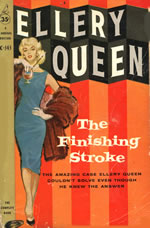The Finishing Stroke
 Cover Artist: Jerry Allison
Cover Artist: Jerry AllisonBy: Queen, Ellery pseudonym of Frederic Dannay and Manfred B. Lee
Publisher: Pocket Books, Inc. (Cardinal edition C-343)
Place of Publication:New York, NY
Catalog #: Kelley Box 355: PS3533 .U4 F56 1959
Contributor: M.A. Moran
General
Era: varied -- Book One: 1905; Book Two: Christmas Eve, 1929 - January 6, 1930; Book Three: Summer, 1957Author as on Cover: Ellery Queen
Publication:1959
Original Date: 1958
Setting: small town (population 6,000) 40 miles from New York City. Literature and literary figures of the time are mentioned. One character expresses some of the "Bolshevik" sentiment of the time and comments about the revolution to come.
Plot Summary
In 1905, an automobile accident results in the pregnant Claire Sebastian's premature delivery. In 1929, this fact is a key ingredient in Ellery Queen's first independent murder investigation, but it isn't until 1957 that Queen actually solves the mystery. Centering around the twelve days of Christmas, twelve house guests, intricate clues, and two dead bodies, there are several twists to this case that even the most discerning reader may have trouble following.Major Characters
Ellery Queen adult male, 25 years old, intelligent, fairly good looking, son of a police detective, mystery novelist ("How young Ellery was may be judged by the fact that he took his reviews seriously."); describes himself as having a "certain brashness."Arthur B. Craig adult male, "a mountain of a man, a sort of cross between President Hoover and Henry the Eighth - huge, square-faced and bearded…." owns a printing company, guardian of young John Sebastian, seemingly genial, affectionate toward John and the young niece he has also raised
John Sebastian (John I) adult male, "dilettante poet of great charm and....some talent....piercing-eyed, lank-haired, Byronic model." Cynical, patronizing, with a streak of meanness
John III adult male, one of John Sebastian's triplet brothers; none of the other guests are aware of his existence, much more grasping and mean-spirited than John I
Others the house guests are, for the most part, there to provide suspects and to confuse the reader. The minister offers a touch of morality, the clairvoyant provides a little humor, Valentina and Marius display unrequited love and the accompanying jealousy
*